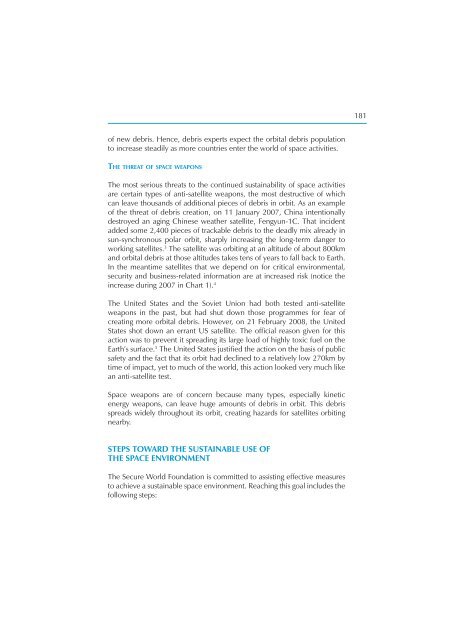Security in Space The Next Generation - UNIDIR
Security in Space The Next Generation - UNIDIR
Security in Space The Next Generation - UNIDIR
Create successful ePaper yourself
Turn your PDF publications into a flip-book with our unique Google optimized e-Paper software.
of new debris. Hence, debris experts expect the orbital debris population<br />
to <strong>in</strong>crease steadily as more countries enter the world of space activities.<br />
THE THREAT OF SPACE WEAPONS<br />
<strong>The</strong> most serious threats to the cont<strong>in</strong>ued susta<strong>in</strong>ability of space activities<br />
are certa<strong>in</strong> types of anti-satellite weapons, the most destructive of which<br />
can leave thousands of additional pieces of debris <strong>in</strong> orbit. As an example<br />
of the threat of debris creation, on 11 January 2007, Ch<strong>in</strong>a <strong>in</strong>tentionally<br />
destroyed an ag<strong>in</strong>g Ch<strong>in</strong>ese weather satellite, Fengyun-1C. That <strong>in</strong>cident<br />
added some 2,400 pieces of trackable debris to the deadly mix already <strong>in</strong><br />
sun-synchronous polar orbit, sharply <strong>in</strong>creas<strong>in</strong>g the long-term danger to<br />
work<strong>in</strong>g satellites. 3 <strong>The</strong> satellite was orbit<strong>in</strong>g at an altitude of about 800km<br />
and orbital debris at those altitudes takes tens of years to fall back to Earth.<br />
In the meantime satellites that we depend on for critical environmental,<br />
security and bus<strong>in</strong>ess-related <strong>in</strong>formation are at <strong>in</strong>creased risk (notice the<br />
<strong>in</strong>crease dur<strong>in</strong>g 2007 <strong>in</strong> Chart 1). 4<br />
<strong>The</strong> United States and the Soviet Union had both tested anti-satellite<br />
weapons <strong>in</strong> the past, but had shut down those programmes for fear of<br />
creat<strong>in</strong>g more orbital debris. However, on 21 February 2008, the United<br />
States shot down an errant US satellite. <strong>The</strong> offi cial reason given for this<br />
action was to prevent it spread<strong>in</strong>g its large load of highly toxic fuel on the<br />
Earth’s surface. 5 <strong>The</strong> United States justifi ed the action on the basis of public<br />
safety and the fact that its orbit had decl<strong>in</strong>ed to a relatively low 270km by<br />
time of impact, yet to much of the world, this action looked very much like<br />
an anti-satellite test.<br />
<strong>Space</strong> weapons are of concern because many types, especially k<strong>in</strong>etic<br />
energy weapons, can leave huge amounts of debris <strong>in</strong> orbit. This debris<br />
spreads widely throughout its orbit, creat<strong>in</strong>g hazards for satellites orbit<strong>in</strong>g<br />
nearby.<br />
STEPS TOWARD THE SUSTAINABLE USE OF<br />
THE SPACE ENVIRONMENT<br />
<strong>The</strong> Secure World Foundation is committed to assist<strong>in</strong>g effective measures<br />
to achieve a susta<strong>in</strong>able space environment. Reach<strong>in</strong>g this goal <strong>in</strong>cludes the<br />
follow<strong>in</strong>g steps:<br />
181








